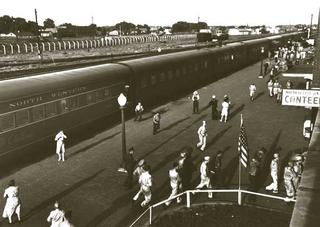North Platte Canteen
|
photo from Union Pacific
|
"North Platte Canteen Dished Up Instant Hospitality, Friendship," by Cindy Connolly, Omaha World-Herald, June 1, 1994
"The old brick train station moved people to tears when it was torn down in the 1970s, and years later memories of it inspired a Harlequin Romance novel. The simple building housed the North Platte Canteen, a community-run hospitality center that welcomed, fed and entertained up to 5,000 service men and women a day during World War II. Half a century later, older North Platte residents become wistful as they recall the troop trains whooshing in and out of the depot and their brief encounters with homesick young Americans. "When those trains would come in and when they'd leave, you would have a big lump in your throat because you just knew that some of them wouldn't come back," said Wylma Cantral, 83, who handed out cookies and cake at the canteen. She said she still feels the lump sometimes. "It was a wonderful experience."
Of the numerous canteens and USO centers set up across the country during the war, the way station at North Platte may have been the most famous. Every day from Christmas 1941 to April 1, 1946, soldiers, sailors and Marines traveling cross-country by train were given free coffee, sandwiches, dessert, cigarettes and magazines at the canteen before reboarding and moving on. Residents of North Platte and 125 other communities in Nebraska, Colorado and Kansas provided the food, reading material and camaraderie. During the whistle-stops that averaged about 10 minutes, friends were made and experiences of a lifetime were stored in memory banks. . .
The canteen was the result of a typical wartime mix-up. Ten days after the bombing of Pearl Harbor in 1941, North Platte residents heard that their own Company D of the Nebraska National Guard would pass through the city by train en route from Camp Robinson, Ark., to the West Coast. About 500 residents rushed to the Union Pacific Railroad station with cookies, candy, cake and cigarettes. They were disappointed when Company D turned out to be from Kansas. But they welcomed the unit with their gifts. The experience gave one woman in the crowd an idea. Rae Wilson, whose brother commanded the local company, arranged for people in the city to meet all of the trains, beginning on Christmas Day 1941. Volunteers from all walks donated their time. Funds were raised from every conceivable source: scrap drives, dances, concerts, movie benefits and cash donations.
Mrs. Dotson kept records on canteen activities. One daily shopping list reads: 160 to 175 loaves of bread, 100 pounds of meat, 15 pounds of cheese, 2 quarts of peanut butter and other spreads, 18 pounds of butter, 45 pounds of coffee, 40 quarts of cream, 500 half-pint bottles of milk and 35 dozen rolls. Every day 18 to 20 birthday cakes were handed out. Such day-to-day dramas, as recorded in the letters on display at the Historical Society museum, provided the material for "I'll Be Seeing You," a Harlequin Romance novel published last year. The author, Kristine Rolofson of Rhode Island, has said at she spent hours reading letters people wrote about the canteen when she visited the museum in the late 1980s.
The canteen was closed in April 1946. For three weeks in 1967 it was reopened for a reunion. The 6 million service men and women who came through the canteen were invited to attend. The end came for the Union Pacific station when it was demolished in 1973, the year the Historical Society museum was built. In May of that year, Mrs. Dotson helped reopen the canteen one last time during North Platte's centennial. When demolition began in November, she said, "I cried like everyone else in North Platte. I kept thinking they should make a museum out of it."
Links:
- Greene, Bob. Once Upon a Town. The Miracle of the North Platte Canteen, published 2002 by HarperCollins
- North Platte Canteen from Martin Steinbeck
- North Platte Canteen from Nebraska Studies
- Charles Kuralt "On the Road" in 1977
